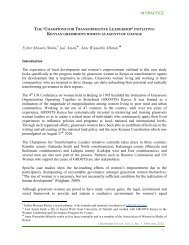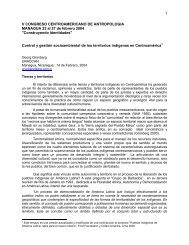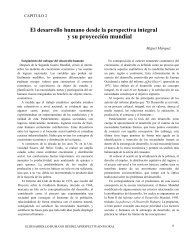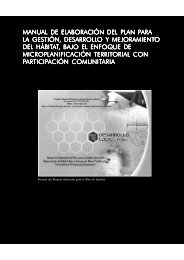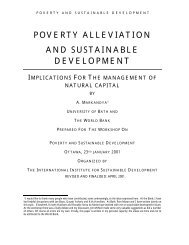The Cluster Initiative Greenbook
The Cluster Initiative Greenbook
The Cluster Initiative Greenbook
You also want an ePaper? Increase the reach of your titles
YUMPU automatically turns print PDFs into web optimized ePapers that Google loves.
Regional and<br />
SME policies<br />
Investment<br />
attraction<br />
policies<br />
Science and<br />
innovation policies<br />
CI<br />
Figure 5<br />
CIs build on three main policy<br />
areas<br />
CIs (see Figure 5 above) are emerging within three distinct policy fields: 1) regional,<br />
industry and SME policies, 2) FDI attraction policies, and 3) science, research and<br />
innovation policies. On the regional side, CIs are implemented to boost development<br />
in weak regions and to rejuvenate declining clusters. Through CIs focus is shifting from<br />
cost cutting (subsidies, tax incentives, etc.) to promoting innovation and upgrading<br />
through new partnerships (Landabaso, 2002). FDI attraction policies have also shifted<br />
their focus from attracting individual firms and production units to a region or country,<br />
to involving clusters and more embedded investments. <strong>The</strong> third policy field where<br />
CIs have made an inroad is science, research and innovation policies. <strong>The</strong> tendency<br />
here is to focus on science-driven industries. In fact, a majority of CIs in the world (see<br />
further Chapter 3) are serving research intensive clusters.<br />
<strong>The</strong> CI lifecycle<br />
Just as clusters have lifecycles, cluster initiatives have lifecycles – in terms both of the<br />
degree of institutionalisation and the objectives of the initiative. (See Figure 6 below.)<br />
<strong>The</strong> need for frequent dialogue among industry, policymakers and other constituents<br />
has no obvious ending point. On the other hand, public financing and initiation activities<br />
have a beginning and an end.<br />
As important as the evolution of the CI is the legacy, or antecedence, of the CI.<br />
Antecedence can involve earlier industry initiatives, such as lobbying activities, or earlier<br />
policy initiatives, such as regional or innovation policies. Established organisations –<br />
e.g. networks, industry associations or other institutions for collaboration (IFCs), etc. –<br />
often have a great impact on the formation of CIs.<br />
After a formation period (with initiative coming from industry, government or in<br />
rare cases academia), the official CI is launched. Unless the CI fails, it will build up a<br />
stronger resource base over time and stronger commitment from the partners. Some<br />
CIs become even more institutionalised (typically financed through membership fees),<br />
which turns the initiative into a formal cluster-based institution for collaboration.<br />
Antecedence Formation CI <strong>Cluster</strong>-based IFC<br />
Time<br />
Figure 6<br />
<strong>The</strong> cluster initiative lifecycle<br />
<strong>The</strong> <strong>Cluster</strong> <strong>Initiative</strong> <strong>Greenbook</strong> • 17




